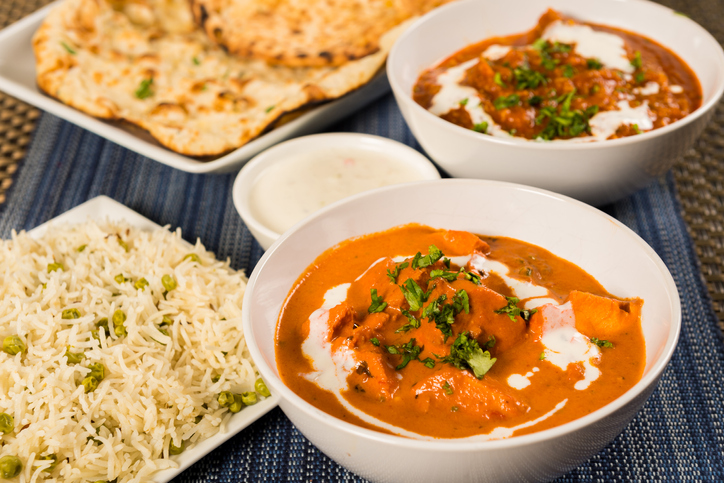
Some of us have fond memories of fall play days as children. Bundled in mittens and knitted scarves, we most likely spent the day building forts out of leaf piles, throwing leaves, or perhaps apple picking and pumpkin patch visiting. But it was what happened after these crisp days when we headed inside many of us remember more. We remember how the luxurious warmth hit our chilly cheeks turned bright-apple red from the cold and the smell of warm, bubbling pots or crockpots filled with delicious foods. That sensation of the first spoonful often stuck to us longer.
When fall finally settles in and hints to us of the colder temperatures of winter, we all tend to begin to crave a warm, fragrant dish that can fill out bellies and radiate warmth throughout our bodies. Fall is the perfect curry season.
Soups and stews always have our fondest regard, but a curry can be so much more when it comes to a meal that is bursting with flavor! And for many of us who may have instantly thought of needing a pantry full of exotic spices, or spices they'd need to order online to cook just one curry: good news! Curry can be as complex or as simple as you need it to be.
What IS Curry?
The food-term of 'curry,' as we see it today in restaurants, on menus, within recipes, or found in pre-made or pre-packaged goods in the grocery store, is—in many ways—not used correctly. The word curry does not refer to a stew or a sauce as we in the Western world know it. In fact, in so many countries, the term became popularized many years ago by colonizers to simplify what they saw as foreign cuisines. The word curry is an anglicized form of the Tamil word, kari, meaning 'sauce,' or 'relish for rice,' that used the curry tree leaves. In other Dravidian languages, namely in Malayalam, Kannada, and Kodava, kari also comes with the meaning of "vegetables (or meat) in any (raw or boiled) curry.
This sauce, gravy, or rice relish is generally heavily spiced with many different herbs and spices in South Asian cuisines and can be anywhere from mild in heat to extremely hot.
What Makes Curry a Curry today?
The word curry being applied to many South and Southeast Asian foods, with dishes such as Thai green curry, Indian Mugh Kari, or Japanese curry, it is easy to realize just how different these dishes are.
In essence, what makes a dish a curry dish is the presence of a sauce flavored by a spice mixture, which means you have a lot of leeways when it comes to experimenting with and making your curry!
But if you're eager to try a curry this fall but not sure if you're ready for or your wallet is prepared for more complex recipes, we have a straightforward recipe for you to start with below that can use either chicken or shrimp.
Simple Chicken or Shrimp Curry
What you'll need:
- 2 tablespoons neutral oil such as canola, corn, grapeseed, sunflower, or peanut, for example.
- 2 large onions, peeled and sliced
- Salt and freshly ground black pepper to taste
- 2 teaspoons of curry powder of your choice
- 1 can of unsweetened coconut milk, or 1 and ½ to 2 cups.
- 1 ½ pound of peeled shrimp or boneless chicken cut into roughly 1-inch chunks.
- 1 cup peeled, seeded, and diced tomato. Canned is perfectly fine. Make sure you cut it and drain it before using it.
• Optional garnish: chopped basil or mint
How to make:
- Place your oil in a large skillet and turn on the heat to medium-high. Add your onions along with a generous sprinkle of salt and pepper and cook, occasionally stirring until onions become golden brown and are very soft, 15 minutes or more. Next, stir in your curry powder and cook for an additional minute.
- Add in your coconut milk and cook until it thickens, 2-5 minutes, making sure to keep stirring. Add your chicken and stir for another 6 minutes, or until the chicken chunks are cooked all the way through. If using shrimp, keep in mind it will cook faster, so cook shrimp until it is opaque, roughly 3 to five minutes.
- Add your tomato and simmer for another minute. Taste and adjust seasoning as needed. Serve over rice and garnish if needed.
Tips and tricks for this recipe:
As you can tell, this is more of a bare-bones curry, which is perfect for a beginner. But what if you've tried curry before, or what if you're a fan of more bold flavors?
We've got ideas for you!
- Switch out the curry powder for a green Thai curry paste. Green curry pastes are mild but stuffed with flavor from kefir leaves, basil, cilantro, lemongrass, ginger, fish sauce, shrimp paste, brown sugar, cumin, and coriander—to name a few of the spices. Whether you choose to make yours homemade or decide to go store-bought, even the store-bought brands of Thai green curry paste pack a burst of delicious taste in every spoonful, excellent for elevating this dish toward more complex flavors.
- Add in a dash of turmeric, cayenne, cumin, ginger, and garlic for more flavor. Powdered is just fine, but fresh, of course, will add a more profound taste profile if you can.
What sort of Meats or Vegetarian Options are used in curry?
The best types of meat to use in a curry are typically chicken, beef, lamb, shrimp, and whitefish. For the vegetarian curry, tofu is a popular addition; lentils and legumes or paneer are also fantastic options.
While this is a very basic recipe, it is the perfect foundation for you to experiment and perfect your very own curry. There are also many different ways to cook curry these days that we hope we can encourage you to try your own!

